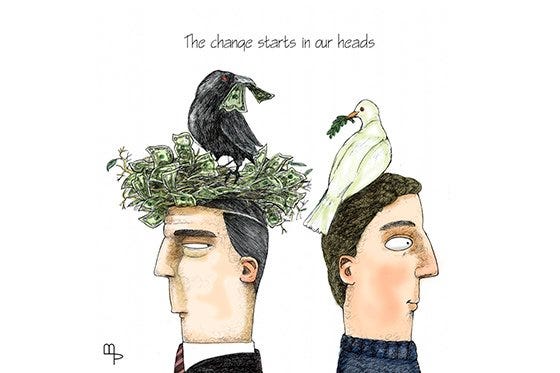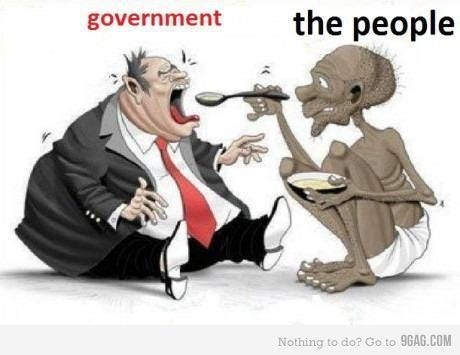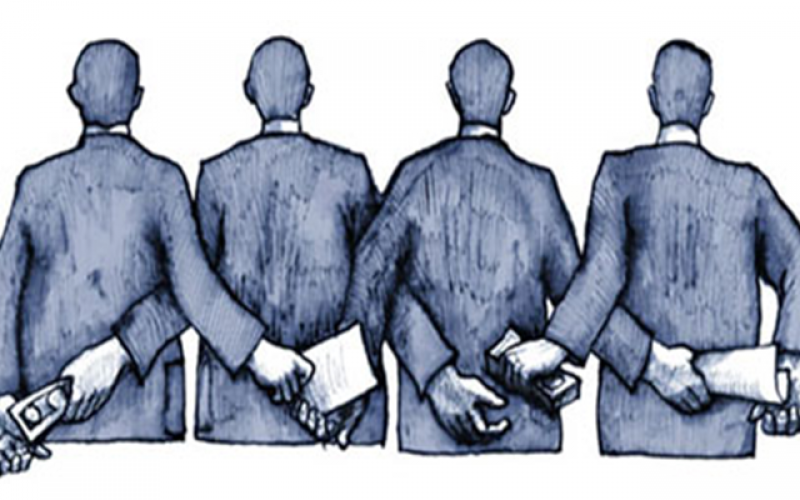(Disclaimer: This piece is completely a thought exercise and rooted only minimally in data and experiences.)

2014 — the BJP comes to power. That of course wasn’t surprising to many. But the manner of the victory and the momentum they have had since then is staggering. Something interesting has been been happening since 2002, and we haven’t seen anything like it, at scale at any rate. And it had to have happened from Gujarat. And had to happen with Modi.
But what made him the most powerful person in India today? How did he get here? What made him overcome embedded stalwarts in the party? Was it just his personality and the popularity of his speeches? Does he command loyalty within the party? Why? Electoral mandate? What is his agenda? What does he know that the rest of party doesn’t?
When we think about politics, we see it as synonymous with corruption. The popular perception is that because greedy men and women get into politics with an unquenchable thirst for power and money. On second thought, however, it seems a little simplistic. And I’ve been wondering how this works. How does something so self serving lend itself to any sort of “system” or “party”? Does the richest politician become the most powerful? How do they stay united behind something as abstract as an ideology?
And I’ve reached a very simple conclusion — it’s economics. More specifically, the economics of corruption. Corruption funds politics. Read that again. Not politicians. Politics. More specifically, it funds political parties and it funds elections and it funds ideology. So, to understand a party’s ideology and it’s political view point and it’s corruption model, it’s crucial to look at the party’s organization and funding model than its personalities.
It’s the Economics, Stupid.
Outflows
Let’s look at a simplified model of the economics of a national party. India has about 700 districts and 6 lakh villages. For a political party to have a national footprint, it probably needs about 100,000 local offices, plus a state level and national level organization — offices and people, like any other corporation.
Rent + people + consumables per office: 50,000 INR per month. That’s a fixed bill of INR 3,00– 500 crore annually. Add to this cost of LS elections — 400 seats @ 25 cr INR each = 10,000 Cr every five years (http://www.ndtv.com/elections-news/rs-30-000-crore-to-be-spent-on-lok-sabha-polls-study-554110) and another 2000 crores every five years for the state election, assembly polls and so on. So about 2,000 crores annually give or take. The number in itself isn’t important. The dimension of it is.
Now, Inflows:
Administrative corruption (services to common people and small businesses—police, transport, jobs, posts, records, licenses, permits, certificates etc)
Local Organized Business Corruption (Liquor vends, LPG gas distribution etc)
Local Extortion (protection money from a shopkeeper for example)
State level Organized business corruption (Real estate, Mines, Natural resources, Liquor, Transport)
State level Lobbying & Extortion
Corruption, as the man on the street experiences it, is largely what I call Administrative and Unorganized Corruption. Typically, the way it works it that every government official needs to collect revenue from the common man and pass on a fixed amount every month to his superior. Anything over and above that fixed amount can be kept for personal benefit. For example, a State Administrative service officer (government salary is at about 75k) needs to pay a fixed amount of 1–2 Lakh per month to his superior, who in turn aggregates it and passes it on to his superior.
(This simple system is fascinating. So many models can and are tried at an individual level by different government officers to meet different levels of ethics and morality — The Robinhood model, The Capitalist model, Honest Rebel model. There is also the aspect of a “department culture” — how does the head of the department set the tone — how does he negotiate his fixed amount with his superior — does he say I’ll get my department to perform giving you street cred but in return I’ll only extract so much from the department? What does he do after that? Pass the message on and keeps the cash? How are “non- economic favours” handled? Does the superior say “do this favour for my friend or family — I will take a lesser amount from you this month?” or does he say — I don’t care, favours or not — you need to deliver this or you are transferred to Mizoram. How does he negotiate the selection of his subordinate officers? Does he maximize inflows or trades off inflow vs performance)
The rest can be clubbed into Business Corruption. The money you get from large corporations for resources, permissions, infrastructure decisions and so on.
The Money Trail.
So this whole money trail ends at the Minister in charge of the department and then on with the CM. What then happens with this gentleman? He needs to deposit it into the Party treasury. How much does he need to pay? Again, a simple view of this negotiation I imagine to be — The party funded 15 crores in the last election and the CM spent say 10 cr and hence they agree on say 100 crores a year to the party. You can imagine the dynamics at play here. A “bankable” candidate with his own street level organisation will negotiate a lower party contribution but get lower funding from the party at election time. The party can choose a candidate who offers a higher party monthly contribution but needs more party contribution and street level support at election time.
Clean Corruption? The second more fascinating strategic choice for the CM and the party is Administrative & Unorganized Corruption as a percentage % of total inflows. Or in simple words — how much do I take from the common man every month? This decision determines his popular perception and his electability. With a “clean CM”, the common man experiences better government services, benefits, roads and utilities. Except that the CM is not really clean — he is just choosing to get a higher portion of his funds from Business Corruption. It’s not an easy choice in its execution. The established system of administrative corruption is far easier to milk and manage.
The sheer costs of running a political party show us that running a clean, corruption-free government is an impossibility unless they have guaranteed donations every month. Yeah, right. (When was the last time any party except AAP canvassed you for donations?)
How do parties differ then? How does the government get better under one party and get worse under another? Why does one party build more roads and the other build less? If its just economics, shouldn’t it all be the same?
The answer lies in your corruption strategy. And here is where Mr. Narendra Modi comes in. But to understand this, let’s see how the Congress Party works.
The Congress invented the Corruption Model in India.The Congress party came into power mainly under the leadership of Gandhi and Nehru with a socialist agenda and with the momentum of having had a primary role in the creation of Independent India. They formed the government and ran the country until 1977 and then again intermittently till 2014 making them the ruling party for about 50 years of 70 years as Independent India. If we assume corruption began with the formation of the government and evolved as a way of funding the expenses of running the party and managing election expenses, we can imagine that people with wealth would come into positions of power in the party by donating to the party. We can then see how the model kept evolving morally where the party leadership kept controlling and managing these funds for the good pf the party and then ended up controlling power distribution in the party. The Congress interestingly never had to build a street level election organization and rode on their brand and freedom fighter credentials to win elections. They had the least costs but by virtue of being a monopoly, had the highest fundability leading to a bigger and bigger party war chest. This model steadily builds on itself until the late eighties, where first the Janata party and then BJP started biting at this monopoly and winning elections with low funds but higher street level volunteer-led organisations. As economic critical mass grew, regional parties started using local issues and identity to win elections and come into power. No party however can even today match the economic might that fifty-year head start gave the Congress. It also explains very easily why even politically inept newbies within the Gandhi family still manage to hold on to that power. The combination of assets, cash and corporate relationships that were held closely by the party leadership and managed by loyal accountants for the party in vague cross-holdings is impossible to usurp.
Congress election strategy is basically Votes for Cash. The cash-rich Congress has since then stayed with the strategy of trading political seats for cash. I imagine Sonia Gandhi being practical with her choice of candidates- “I don’t understand political context. Who comes in with highest probability of winning elections and with least ask of my party funds?”
Effectively, an inorganic acquisition strategy — that simple equation has defined Congress electoral strategy for the last couple of decades. It explains why we see so many power centres in the Congress Party and their love of regional alliances.
BJP strategy The BJP on the other hand initially rode on the Ram Janmabhoomi movement to capture electoral mandate and rode to power. They have had a few short years at the top but being a relative startup were far more unified in their ideology and their leadership under AB Vajpayee and LK Advani. After coming to power, they inherited some of the corruption systems that the Congress has built and probably started to fund themselves and their partner organisations. I think Pramod Mahajan was the driving force for collating the thinking on how to harness funds and had started to really transition the party into a commercial entity at a national level.
Gujarat Something different happened in Gujarat. Narendra Modi came to power as a relative outsider and by sheer luck or genius intent found himself with the electoral mandate. I don’t know whether this was due to circumstance or innovation, but I imagine he looked at the local funding model in the context of the unrest for the man on the street, and decided to focus exclusively on Corporate or Business Corruption to fund his party and local organisation. It’s entirely possible that this is by sheer luck as his some of the nation’s largest corporates came from Gujarat and due to its ports and trading activity had a heavy bias in being invested there. Leveraging that into a business relationship seems like the only logical way to relieve the pressure on Administrative and Unorganized corruption. It’s the only way that an newbie outsider CM could harness his government’s administrative resources and ask them to provide a smooth ride for the man on the street and restore his confidence. “No funds required from the government to the party.”
This simple choice allowed the CM to focus on selecting the best candidates for ministerial and senior officer roles. We can take this even further and imagine that the CM says to his ministers and officials, you perform and I’ll take care of you. You don’t need any revenues from your departments. He does this for a year and then another and realizes he is getting political credit and earning him an electoral mandate. His next election then lets him go back to his corporate sponsors and say, okay look, I am cleaning up the administration and creating infrastructure for you. For this, I am going to need a 1,000 crores from you every year. For the corporates, this becomes an easy deal — the CM has just offered a bulk discount on the thousands of crores I bleed every year at the hands of his government at his ports and his license and excise offices.
This centralized corruption strategy starts to do a couple of things — you start to control the party and hence the elections, and second, you really start to control the government for performance. You effectively subsidize the common man through the goods and services he consumes from the private sector and the resulting profits. You start to select ministers and leaders for performance rather than “party revenues”. You are less reliant on local leaders for elections, and in effect can run a performance government, creating massive economic opportunity for corporations, which then goes back to reinforce his value propostion to both his stakeholders- the voter on the street and the corporate promoter.
What happens next? The Scale up and the Lock-in.
You then offer the central party leadership a massive fund infusion for the party elections in return for becoming the PM candidate and saying that I will manage the party funds as well, effectively controlling the entire election and candidate strategy. You have just done what the Congress has done for three decades- control the party by controlling the inflows. You win the election by outspending your fiscally conservative competition and with a better strategy. The unified face of the party allows you to control the message and win you a national election.
What happens next? Now you have got to pay your sponsors back. You then deploy the same centralised corruption strategy at a national level. You deploy international strategy as a new growth lever for your corporate sponsors. You push the government into high performance mode on power, roads, railways — generating economic growth and political momentum.
The counterstrike. Even with all this, you still worry about the next election. For one simple reason. Your main rival still has 5X the resources you have. Theoretically, the Congress could break the bank in the next election and outspend the BJP to dilute the party’s electoral mandate, especially in the regional constituencies.
You do two things — One, you neutralize the Congress with the only way you can neutralize their resources — Black money and Demonetization. Even if you don’t reduce their resources, you at least succeed in reducing their liquidity. You take a hit too but if you look at the damage you cause your biggest rival, this is a a shin graze.
You then go ahead and remove the cap on anonymous political donations, effectively legalizing the entire transaction between your corporate sponsors and your party treasury.
With these two simple steps, you have just changed the game for political domination in India. And that is what I believe is happening in India today.
What of ideology? What of the manifesto? Well, it’s honestly the medium that can control the message. If you run the government and the corporations, you effectively control nearly everything. You can manage messages locally to suit or modify the narrative.
Two exceptions remain. The Judiciary and the Internet.


No comments:
Post a Comment
Note: Only a member of this blog may post a comment.